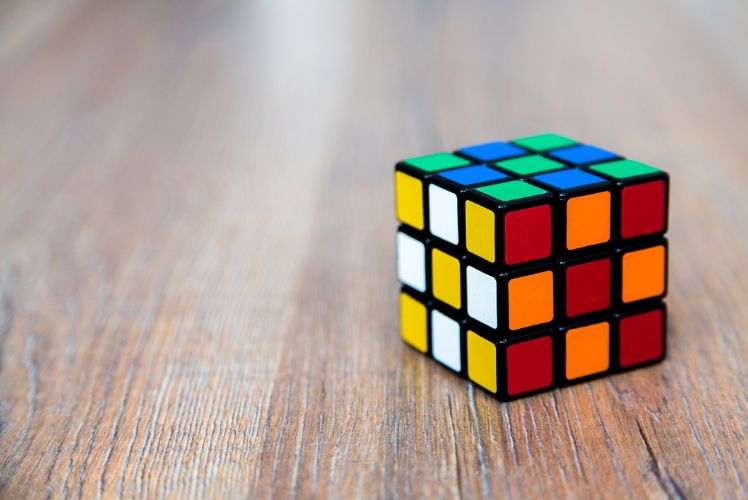Introduction: Unveiling the Enigma of the Rubik's Cube
Welcome to the colourful world of the Rubik's Cube! If you've ever found yourself captivated by this iconic puzzle, you're certainly not alone. Let's take a journey back in time to uncover the fascinating history behind this timeless toy and explore why it continues to hold a special place in the hearts of millions around the globe.
Brief History:
The story of the Rubik's Cube begins in the vibrant city of Budapest, Hungary, in the early 1970s. It was during this time that a Hungarian architect and professor of architecture named Ernő Rubik stumbled upon the idea that would eventually revolutionise the world of puzzles. In 1974, Rubik created the first prototype of what would later become known as the Rubik's Cube, initially calling it the "Magic Cube." Little did Rubik know at the time that his invention would soon become a worldwide sensation, captivating the minds of people across generations and cultures. In 1980, after years of refinement and development, the Rubik's Cube as we know it today was officially launched, sparking a craze that would sweep the globe.
Enduring Popularity and Appeal:
So, what is it about the Rubik's Cube that has made it such an enduring icon? At its core, the appeal of the Rubik's Cube lies in its simplicity yet infinite complexity. With its colourful, twisting faces, the cube presents a tantalising challenge that promises hours of entertainment and mental stimulation..
But beyond its puzzling allure, the Rubik's Cube has also captured the imagination of people worldwide due to its universality. Regardless of age, background, or skill level, anyone can pick up a Rubik's Cube and embark on the journey of solving its colorful conundrum. Over the decades, the Rubik's Cube has transcended its status as a mere toy, becoming a symbol of creativity, problem-solving, and perseverance. It has inspired countless enthusiasts to push the boundaries of their cognitive abilities, leading to the development of advanced solving techniques and even competitive speedcubing competitions
As we delve deeper into the world of the Rubik's Cube, prepare to unlock the secrets of this timeless puzzle and discover the joy of unraveling its intricate patterns. Whether you're a seasoned solver or a curious beginner, there's no denying the magic that lies within the colourful confines of the Rubik's Cube. So, grab your cube, embrace the challenge, and let's embark on this exhilarating adventure together!.
The Challenge of Solving the Rubik's Cube: Unraveling the Puzzle
Embarking on the journey of solving the Rubik's Cube is akin to setting sail on a colourful sea of twists, turns, and tantalising challenges. At its heart lies a simple yet elusive goal: to align each face of the cube with a single colour. But make no mistake—this seemingly straightforward task is a puzzle of monumental proportions, one that has captivated minds and sparked curiosity for decades.
The Goal: Aligning Colours on Every Face
At first glance, the Rubik's Cube may appear as nothing more than a six-sided enigma adorned with an array of vibrant colours. However, beneath its colourful facade lies a complex web of interconnected pieces, each waiting to be manipulated into perfect alignment. The ultimate objective of solving the Rubik's Cube is to restore order to its chaotic arrangement by organising each of its six faces so that every square shares the same colour. Sounds simple, right? Think again. With a staggering number of possible permutations—43 quintillion, to be precise—the Rubik's Cube presents a challenge that is as daunting as it is delightful.
Common Misconceptions: Debunking the Myths
As with any perplexing puzzle, a host of misconceptions often swirl around the Rubik's Cube, leaving many aspiring solvers feeling perplexed and perplexed. Let's take a moment to debunk some of the most common myths that surround this iconic cube:
Myth #1: Solving the Rubik's Cube is purely a matter of luck. Contrary to popular belief, solving the Rubik's Cube is not a game of chance but rather a test of strategy, logic, and spatial reasoning. While luck may play a small role in some instances, mastery of solving techniques and algorithms is essential for achieving success.
Myth #2: You must possess genius-level intellect to solve the Rubik's Cube. While solving the Rubik's Cube may seem like a feat reserved for the brainiest among us, the truth is that anyone can learn to crack its colourful code with practice, patience, and perseverance. With the right guidance and determination, even the most novice solver can conquer the cube.
Myth #3: Solving the Rubik's Cube requires memorising countless algorithms. While it's true that memorising algorithms can be helpful in solving the Rubik's Cube efficiently, it's not the only path to success. Understanding the underlying principles of cube manipulation and learning intuitive solving methods can be just as effective—and far more rewarding.
In the end, the challenge of solving the Rubik's Cube is not merely about arranging colours or mastering algorithms—it's about embarking on a journey of exploration, discovery, and personal growth. So, arm yourself with determination, embrace the challenge, and prepare to unravel the mysteries of this iconic puzzle one twist at a time.
Getting Started: Mastering the Basics of the Rubik's Cube
So, you've decided to take the plunge and dive into the colourful world of the Rubik's Cube. Congratulations! But where do you begin? Fear not, fellow adventurer, for we're about to embark on a journey of twists, turns, and triumphs as we unravel the secrets of this iconic puzzle.
Introduction to Basic Moves: Twists, Turns, and Rotations
At the heart of solving the Rubik's Cube lies a fundamental understanding of its basic moves—simple yet crucial manoeuvres that will serve as the building blocks of your solving journey. Twists: The Rubik's Cube is comprised of individual cubies—small, square blocks—that can be twisted along their axes to create movement. A twist involves rotating a single face of the cube either clockwise (90 degrees) or counterclockwise (90 degrees). Turns: Turning the Rubik's Cube involves rotating an entire layer of cubies either clockwise or counterclockwise. This can be achieved by grasping opposite sides of the cube and rotating them in opposite directions, effectively shifting entire rows of cubies. Rotations: Rotating the Rubik's Cube involves turning it around in your hands to view different faces. This can help you gain perspective and plan your next moves strategically.
Explanation of Cube Notation: R, L, U, D, F, B
Now that we've covered the basic moves, let's delve into cube notation—a standardised system used to describe specific manoeuvres and sequences on the Rubik's Cube.
- R (Right): Rotate the right face of the cube clockwise.
- L (Left): Rotate the left face of the cube clockwise.
- U (Up): Rotate the top face of the cube clockwise.
- D (Down): Rotate the bottom face of the cube clockwise.
- F (Front): Rotate the front face of the cube clockwise.
- B (Back): Rotate the back face of the cube clockwise.
By using these simple notations, you can execute precise moves and sequences on the Rubik's Cube with ease. For example, the sequence "R U R' U'" would instruct you to rotate the right face clockwise, then the top face clockwise, followed by a counterclockwise rotation of the right face, and finally a counterclockwise rotation of the top face.
Armed with a basic understanding of moves and notations, you're now ready to begin your journey of solving the Rubik's Cube. So, grab your cube, flex those fingers, and let the twisting and turning begin!
Step-by-Step Guide to Solving the Rubik's Cube: Unlocking the Puzzle
Congratulations on taking the plunge into the world of Rubik's Cube solving! Prepare to embark on an exciting journey filled with twists, turns, and triumphs as we unravel the secrets of this iconic puzzle. Fear not, for we'll break down the solving process into manageable steps and equip you with the tools you need to conquer the cube.
1. Solving the First Layer (the Cross):
Start by choosing a colour to solve first (usually white or any colour of your preference).
Begin by solving the white cross on the bottom layer, aligning the edge pieces with the center piece of the white face.
Focus on one edge at a time, using intuitive moves to position them correctly.
2. Completing the First Layer Corners:
With the white cross in place, solve the four corner pieces of the first layer by positioning them above their corresponding center pieces. Use simple algorithms to insert the corner pieces into their correct positions while maintaining the integrity of the cross.
3. Second Layer Edges:
Now, it's time to tackle the second layer. Focus on solving the four edge pieces that belong in the middle layer. Utilise intuitive techniques and algorithms to pair up the edge pieces and insert them into their designated spots.
4. Orienting the Last Layer Edges (OLL):
With the first two layers complete, turn your attention to the last layer. Begin by orienting the edges of the last layer so that they match the colours of their adjacent center pieces. Employ algorithms to manipulate the edges into their correct orientations while keeping the rest of the cube intact.
5. Permuting the Last Layer Corners (PLL):
Finally, it's time to tackle the last layer corners. Use algorithms to permute the corner pieces into their correct positions, ensuring that each corner is in its designated spot.
Tips for Efficient Solving and Common Algorithms:
Practice makes perfect! Familiarise yourself with common algorithms for each step of the solving process, and don't be afraid to experiment with different techniques.
Stay patient and persevere through challenging moments. Solving the Rubik's Cube is a skill that takes time and dedication to master. Take advantage of online tutorials, guides, and resources to enhance your solving abilities and expand your knowledge.
Above all, have fun! The Rubik's Cube is as much about the journey as it is about the destination. Embrace the challenge, celebrate your successes, and enjoy the satisfaction of cracking the cube.
Armed with this step-by-step guide and a handful of helpful tips, you're well on your way to becoming a Rubik's Cube-solving master. So, grab your cube, dive in headfirst, and let the twisting and turning begin!
Unlocking the Next Level: Advanced Techniques and Speedcubing
Welcome to the fast-paced world of advanced Rubik's Cube solving! As you delve deeper into the colourful labyrinth of the cube, you'll discover a treasure trove of techniques and strategies that will take your solving skills to new heights. Let's embark on this exhilarating journey together and explore the thrilling realm of advanced techniques and speedcubing.
Introduction to Advanced Solving Methods: CFOP, Roux, ZZ
Gone are the days of simple twists and turns—prepare to elevate your solving game with advanced solving methods such as CFOP, Roux, and ZZ.
CFOP (Cross, F2L, OLL, PLL): This popular method breaks down the solving process into four key steps: building the cross, solving the first two layers (F2L), orienting the last layer (OLL), and permuting the last layer (PLL). By mastering CFOP, solvers can achieve lightning-fast solve times and unlock new levels of efficiency.
Roux Method: Named after its creator, Gilles Roux, this method offers an alternative approach to solving the Rubik's Cube by focusing on block-building and intuitive techniques. With its emphasis on fewer moves and efficient algorithms, Roux method solvers can achieve impressive solve times while maintaining a fluid solving style.
ZZ Method: Short for "Zbigniew Zborowski," the ZZ method is renowned for its emphasis on block-building and advanced lookahead techniques. By prioritising the creation of key blocks and optimising move sequences, ZZ method solvers can tackle the Rubik's Cube with speed and precision.
Tips for Improving Solving Speed and Efficiency
Ready to shave seconds off your solve time and reach new personal bests? Here are some invaluable tips for enhancing your speed and efficiency:
Practice, practice, practice: Consistent practice is key to mastering advanced solving methods and refining your techniques. Set aside dedicated practice sessions to hone your skills and tackle challenging algorithms.
Focus on lookahead: Develop the ability to anticipate future moves and plan your sequences in advance. By improving your lookahead skills, you'll be able to execute moves more efficiently and maintain a steady solving pace.
Learn advanced algorithms: Expand your repertoire of algorithms to include advanced sequences that are tailored to specific solving scenarios. Experiment with different algorithms and techniques to find the ones that work best for you.
Stay relaxed and focused: Keep calm under pressure and maintain focus throughout your solves. Avoid rushing or becoming flustered—instead, approach each solve with a clear mind and steady hands.
Overview of the Competitive Speedcubing Scene
Think you've got what it takes to compete on the global stage? Dive into the exciting world of competitive speedcubing and test your skills against the best of the best.
Competitions: From local events to international championships, competitive speedcubing offers a thrilling platform for cubers to showcase their talents and compete for coveted titles. Attend competitions in your area to connect with fellow cubers, challenge yourself, and push your limits.
World Records: Marvel at the incredible feats of speedcubing champions as they shatter world records and push the boundaries of what's possible. Follow the latest developments in the speedcubing community and witness history in the making as records fall and new champions emerge.
Community and Camaraderie: Join a vibrant community of speedcubers from around the world and share your passion for the cube. Whether you're swapping solving tips, discussing the latest algorithms, or cheering on fellow cubers at competitions, the speedcubing community offers a welcoming and supportive environment for enthusiasts of all skill levels.
Armed with advanced techniques, speedcubing prowess, and a passion for the cube, you're poised to embark on an exhilarating journey of speed, skill, and success. So, grab your cube, embrace the challenge, and let the speedcubing adventure begin!
Beyond Solving: Exploring Rubik's Cube Variations and Challenges
So, you've mastered the art of solving the classic Rubik's Cube—congratulations! But did you know that the world of Rubik's Cube extends far beyond the iconic 3x3 puzzle? Prepare to embark on an exciting journey of exploration as we delve into the wide array of Rubik's Cube variations and challenges that await.
Exploration of Different Rubik's Cube Variations:
From the classic 3x3 to mind-bending multilayered puzzles, the Rubik's Cube universe offers a diverse range of variations to test your skills and challenge your mind. Here are just a few of the captivating variations you might encounter:
4x4 Cube: Also known as the Rubik's Revenge, the 4x4 Cube introduces an extra layer of complexity with its expanded size and additional pieces. With its larger grid and increased challenge, the 4x4 Cube promises a thrilling twist on the classic solving experience.
5x5 Cube: The 5x5 Cube, or Professor's Cube, takes the challenge to new heights with its five layers of cubies and intricate design. As you navigate the intricate patterns and intricate mechanisms of the 5x5 Cube, you'll discover a whole new dimension of solving satisfaction.
Megaminx: Say hello to the Megaminx—a dodecahedral puzzle that adds a whole new level of complexity to the Rubik's Cube family. With its twelve sides and unique shape, the Megaminx offers a fresh and exhilarating solving experience that will put your skills to the test.
Pyraminx: Ready to think outside the cube? Enter the Pyraminx—a pyramid-shaped puzzle that challenges solvers to navigate its triangular faces and edges. With its simple yet captivating design, the Pyraminx offers a fun and accessible alternative to traditional cube solving.
Fun Challenges and Games to Try with the Rubik's Cube:
Looking to add some excitement to your cube-solving routine? Why not shake things up with a few fun challenges and games? Here are some ideas to get you started:
Blindfolded Solving: Test your memory and spatial awareness by attempting to solve the Rubik's Cube blindfolded. With practice and perseverance, you'll be amazed at what you can achieve without even seeing the cube.
One-Handed Solving: Put your dexterity to the test with one-handed solving. Challenge yourself to solve the Rubik's Cube using only one hand, mastering fluid movements and precise fingerwork along the way.
Race Against the Clock: Set a timer and see how quickly you can solve the Rubik's Cube. Whether you're aiming for a personal best or competing against friends, the thrill of the race will keep you coming back for more.
Cubing Challenges: Explore a variety of cubing challenges, such as solving the cube with your feet, solving multiple cubes simultaneously, or creating custom solving patterns and sequences. Get creative and challenge yourself to think outside the box—or should we say, the cube!
With a world of Rubik's Cube variations and challenges at your fingertips, the fun never stops. So, grab your favourite cube, embrace the challenge, and let the adventures begin!
Closing Thoughts: Reflecting on the Magic of the Rubik's Cube
As we come to the end of our journey through the colourful world of the Rubik's Cube, it's time to pause and reflect on the magic and wonder that this iconic puzzle brings into our lives. From its humble beginnings to its enduring legacy, the Rubik's Cube has touched the hearts and minds of millions around the globe, myself included.
Personal Anecdotes or Experiences with the Rubik's Cube:
I'll never forget the first time I laid eyes on a Rubik's Cube—a mesmerising kaleidoscope of colours and possibilities that seemed to beckon me into its enigmatic embrace. With trembling hands and a racing heart, I embarked on the exhilarating journey of solving the cube, savouring each twist and turn as I unraveled its mysteries one by one. As the days turned into weeks and the weeks into months, my love for the Rubik's Cube only grew stronger. I revealed in the satisfaction of each successful solve, marvelled at the intricacies of advanced techniques, and cherished the camaraderie of fellow cubers who shared my passion for the cube.
Invitation for Readers to Share Their Own Rubik's Cube Stories and Experiences:
But enough about my journey—now it's your turn! Whether you're a seasoned solver, a curious beginner, or somewhere in between, I invite you to share your own Rubik's Cube stories and experiences with our community. Did you conquer the cube after months of dedicated practice? Did you discover a clever solving technique that revolutionised your approach? Or perhaps you have a fond memory of solving the Rubik's Cube with friends and family on a rainy afternoon. Whatever your story may be, I'd love to hear it! Join the conversation, share your insights, and let's celebrate the magic of the Rubik's Cube together.
In Conclusion:
As we bid farewell to the Rubik's Cube—for now, at least—I'm filled with gratitude for the joy, challenge, and inspiration it has brought into our lives. May we continue to twist, turn, and unravel its mysteries for years to come, embracing the adventure with open hearts and curious minds. Until next time, happy cubing!





















